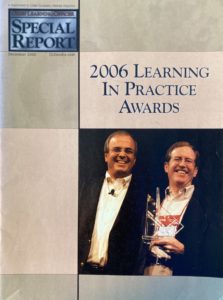 Chief Learning Officer recently sat down for a conversation with David Vance, executive director for the Center for Talent Reporting. Vance is the founding and former president of Caterpillar University and the author of “The Business of Learning.” In 2006, he was awarded CLO of the Year.
Chief Learning Officer recently sat down for a conversation with David Vance, executive director for the Center for Talent Reporting. Vance is the founding and former president of Caterpillar University and the author of “The Business of Learning.” In 2006, he was awarded CLO of the Year.
Chief Learning Officer: Where is your hometown?
I grew up in South Bend, Indiana, not far from the campus of Notre Dame. So that meant on football weekends, we could hear the roar of the crowd in the distance.
CLO: What was your official first job in learning and development?
Well, my first job and last job in learning and development was to run Caterpillar University. Before that I was the chief economist at Caterpillar. When I was asked to start Caterpillar University, that was my first exposure to corporate learning aside from my being a student in it. So maybe a little bit of a different track than others have taken. I came in sideways.
CLO: What lessons did you learn in 2020 that you plan on taking with you into 2021?
One lesson is that things can always get worse. I’m an optimist, so that kind of lesson comes hard to me because I always look for the good, and I like to think that good things will happen. But this has taught us that you can’t always rely on that. But even when things begin to get bad, they could be worse. In our generation, this is certainly the worst thing that’s happened to us. Probably the worst that’s happened since World War 2, to the United States. A lot of us grew up in a very nice time when really bad things didn’t happen. Vietnam was bad and 9/11 was bad, but we’ve way surpassed those in fatalities now. So things can always be worse. And that makes you appreciate the rest of the times more. I think we learned how resilient people are and I think we learned that learning and development is up to the challenge. L&D departments turned on a dime and surprised a lot of leaders. That was a great opportunity for us to show how strategic we can be, how we can be a good business partner and the direct role we can help play in our organization’s success.
CLO: What sort of organizational metrics, analytics and data are especially important for L&D teams to be paying attention to right now?
I hope everyone’s measuring the virtual, so you need to be measuring the usage. Hopefully, that’s captured in LMS without any extra work, but you also need to be sending the surveys out. You might have to change a couple of participant reaction surveys from what you did for ILT, but most of the questions would remain about content, about the instructor. You’d want to add some about the experience. How hard was it to find this? Did you navigate OK? Was the quality OK?
Also, in a lot of organizations, at the same time they switched to virtual, they have emphasized the content they have available on their portal. They’ve emphasized the e-learning they have in their catalog. I hope they’ve also emphasized any knowledge-sharing communities of practice that exist out there. All of these are great alternatives to ILT and most organizations have some of these already going. My hope is that they’ve ramped these up, they’ve publicized them, they’ve marketed them, and they need to be gathering data on those. So if you weren’t already gathering data, you should be gathering usage data on these things, content on your portal and knowledge-sharing and all those things. And you should also be getting participant reactions for those. Now, some things are going to require maybe a little different way of gathering data. For instructor-led, or even e-learning, send out a survey right after the course is done and ask for feedback. For portal content, you can’t do that. So I think instead you’ve got to go to a quarterly, more general survey. You need to get a pulse check. That’s how you’re going to get feedback. It’s going to be different. So maybe a different way of measuring it than we did before.
If a lot of people were going out there now for these new learning opportunities, it’s a great chance for L&D to capture their feedback. Because this is something you probably don’t get right to begin with. We’re big believers these days in [being] agile and getting in and getting [it] 80 percent right, and then learning.

CLO: How do you enjoy spending your time outside of work?
We have two dogs, Spinone Italianos. We love taking them out. We have a place out back, an open space where we can take them for a walk every day and they can run free. And then we take them to the mountains for their special treat where they can go up there and explore. We like walking and hiking, and then I like backpacking with my son, a tradition we’ve done since he was five. He’s 33 now, and we’ve kept it going. Each summer we take our backpacking trip.
CLO: What book, either audio or physical, or podcast has gotten you through this past year and the pandemic?
I like science fiction. I’m reading a series by Gene Johnson right now, but almost any kind of science fiction. I like future- or space-oriented science fiction the best. That’s part of my optimism about the future. I was thinking by now we’d have more aspects of the Jetsons. I was always, as a boy growing up, waiting to have my space car so I could zoom around. So it’s fun imagining the future.
CLO: In your opinion, what are some components of a robust learning and development program?
I have a passion for running learning like a business. By that, I mean with business discipline. It has nothing to do with profit. Have a plan with specific measurable goals. You’ll have worked that out in advance with the stakeholders. So like, if you could support a goal to increase sales in your company, you could work with a head of sales and agree on the learning, agree on the target audience, agree on a measure of success for that, like the impact you might have. And once you have a plan agreed upon, then you’ll execute it with discipline, just like your colleagues in sales or manufacturing. That’s what running learning like a business is. I’m advocating for a proactive approach where, at the beginning of the year, you set up your plan. It can change if something changes, like COVID, but you’ve put a stake in the ground. I think the more we do that, the more credibility we get.
CLO: What advice do you have for CLOs and learning leaders as they take on 2021?
I would build on the trust and progress that they’ve developed this year. They’ve got their CEOs and CFOs and senior leaders looking at them in a very favorable light right now. Build on that. Put a business plan for learning together with senior leaders’ help for next year right now, when they’re looking at you favorably. When has there been a better time really to ask for maybe another person, to ask for another $100,000 in your budget? You’ve shown them the difference you can make this year. Tell them what you could do if they give you a little more resources. If you work for a publicly traded company, data integrity is about to become incredibly important. A lot still haven’t heard about the SEC’s rule on August 26, effective November 9 [last] year, requiring publicly traded companies to disclose human capital. That includes training and development. So starting right now, companies should be talking about their human capital in their quarterly and annual financial releases. Specifically, how much they spend on training and development.
I would also say there’s an opportunity after the big switch to virtual this year to look at restructuring all of your learning. And I think there’s a better way going forward. The big switch to virtual has convinced people that other avenues are possible besides ILT, but why not go another step further? Why not, instead of having, let’s say, a four-week-long or six-week-long onboarding program, or a four-week-long basic skills program, why not see if you can cut that down to one week? You don’t have to bring them back physically, we’ve learned that now, to a classroom. Also, have performance support ready for them. Some things you don’t need to teach them and then hope they remember so they can use it in six months. Most of us are going to forget it before then. So instead, just have a resource available so when they get stuck, they can go get the resource. Why not use this opportunity, now that we’re all in the midst of change here, to restructure how we approach learning, and move away from longer initial ILTs to more nimble, more agile, short pieces of learning in the work stream at the time of need?
ALSO READ: Vance’s column, “The Business of Learning.”
This article has been edited for brevity.















